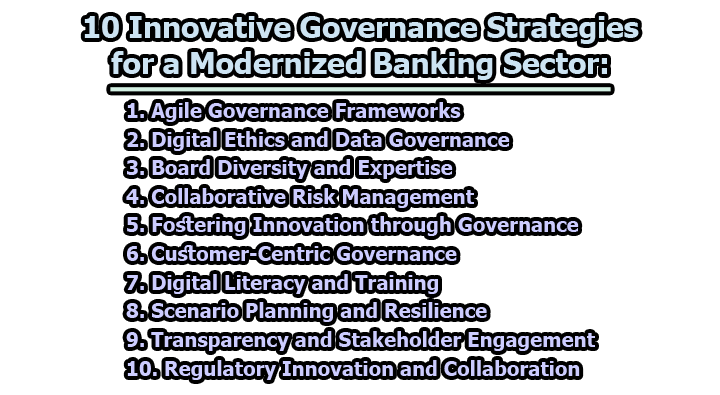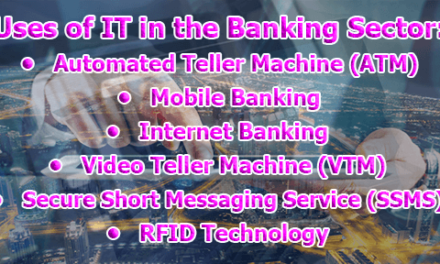10 Innovative Governance Strategies for a Modernized Banking Sector:
In a rapidly evolving banking landscape, characterized by technological breakthroughs and changing consumer expectations, the traditional paradigms of governance are being put to the test. The convergence of digital banking, fintech disruptions, and the integration of technology within financial services necessitates a comprehensive reevaluation of governance strategies. In this article, we delve into the 10 innovative governance strategies for a modernized banking sector.
1. Agile Governance Frameworks: Enhancing Responsiveness
Agility is a cornerstone of effective governance in a modernized banking sector. Traditional governance structures, often hierarchical and rigid, can hinder prompt decision-making in the face of swift market changes. Implementing agile governance frameworks involves decentralizing decision authority, empowering cross-functional teams, and embracing iterative processes. This approach enables financial institutions to adapt quickly to dynamic market shifts while upholding compliance standards. Agile governance fosters collaboration, transparency, and the ability to seize emerging opportunities without sacrificing regulatory alignment.
2. Digital Ethics and Data Governance: Ensuring Responsible Innovation
As the digital era advances, banks increasingly rely on data-driven insights to make informed decisions and provide personalized services. Ethical considerations are paramount to safeguard customer trust and regulatory compliance. Innovative governance strategies must prioritize robust data governance protocols that encompass data privacy, security, and transparency. Banks should actively address algorithmic biases, potential data breaches, and the responsible utilization of customer information. By maintaining a strong ethical foundation, banks can embrace technology-driven innovation while maintaining the integrity of customer relationships.
3. Board Diversity and Expertise: A Holistic Governance Approach
A modernized banking sector demands a board composition that mirrors the multifaceted challenges presented by technology-driven transformations. Traditional board structures may lack the diversity of expertise needed to understand the complexities of digitalization, cybersecurity, and shifting customer behaviors. Incorporating board members with varied backgrounds in technology, finance, cybersecurity, and customer engagement ensures a comprehensive understanding of the evolving landscape. A diverse board contributes to effective risk evaluation, informed decision-making, and the pursuit of innovative opportunities.
4. Collaborative Risk Management: Addressing Interconnected Threats
The technological revolution blurs the boundaries between different sectors, creating new and interconnected risks that transcend traditional banking norms. Collaborative risk management strategies involve partnering with regulators, industry peers, and technology experts. By leveraging collective intelligence, banks can gain a more comprehensive view of potential threats. Collaborative risk assessment fosters knowledge-sharing, enhances risk evaluation accuracy, and improves the collective capacity to respond proactively to emerging challenges.
5. Fostering Innovation through Governance: Cultivating a Culture of Creativity
Innovation is a cornerstone of thriving in the modern banking sector. Governance strategies should actively encourage and support a culture of innovation within financial institutions. This requires creating dedicated channels for idea generation, experimentation, and learning from failures. Importantly, innovative governance ensures that these practices align with regulatory requirements. By nurturing a culture of innovation, banks can adapt to evolving customer expectations, technological advancements, and disruptive market forces.
6. Customer-Centric Governance: Prioritizing User Experience
Heightened customer expectations in the digital age demand a governance approach centered on customer needs and experiences. Modernized governance strategies involve actively gathering and incorporating customer feedback into decision-making processes. By aligning products, services, and processes with customer preferences, banks can build stronger customer relationships and enhance customer loyalty. Customer-centric governance ensures that technology-driven advancements enhance rather than compromise the customer experience.
7. Digital Literacy and Training: Empowering Stakeholders
In the modernized banking sector, every stakeholder, from board members to employees, must possess a solid understanding of technology and its implications. Governance strategies should incorporate ongoing digital literacy training to ensure that decisions are well-informed and aligned with technological trends. This empowers stakeholders to make informed choices regarding technology adoption, risk management, and compliance.
8. Scenario Planning and Resilience: Anticipating the Unforeseen
Rapid technological changes can render existing business models obsolete almost overnight. Innovative governance involves proactive scenario planning exercises that anticipate potential disruptions. By envisioning different future scenarios, banks can develop strategies to mitigate risks and enhance the sector’s overall resilience. This forward-looking approach enables institutions to adapt swiftly and effectively to unforeseen challenges while minimizing disruption to operations.
9. Transparency and Stakeholder Engagement: Building Trust through Openness
In a landscape characterized by transparency expectations, modernized banking governance must prioritize clear and open communication. Institutions should actively engage with stakeholders, including customers, investors, employees, and regulators. Transparent governance practices involve sharing information about governance approaches, performance metrics, and strategic directions. Openness enhances trust, strengthens accountability, and cultivates a favorable reputation.
10. Regulatory Innovation and Collaboration: Shaping the Future Together
Innovative governance extends beyond compliance; it involves actively collaborating with regulatory bodies to shape new rules that accommodate technological advancements. Effective governance in a modernized banking sector requires institutions to proactively engage with regulators, sharing insights, and contributing to the development of regulations that foster innovation while ensuring stability and consumer protection.
In conclusion, as the banking sector undergoes radical transformation fueled by technological progress, innovative governance strategies emerge as essential tools for achieving sustainable success. By adopting agile frameworks, ensuring ethical data practices, embracing diversity, collaborating on risk management, nurturing innovation, prioritizing customers, fostering digital literacy, planning for resilience, promoting transparency, and engaging with regulators, financial institutions can effectively navigate the challenges and harness the opportunities of a modernized banking landscape. Collectively, these strategies lay the foundation for governance that is not only adaptable and compliant but also visionary, resilient, and aligned with the demands of the digital age.
Frequently Asked Questions [FAQs]:
What are innovative governance strategies in the banking sector?
Innovative governance strategies refer to forward-thinking approaches employed by financial institutions to effectively manage and navigate the challenges presented by rapid technological advancements and changing industry dynamics. These strategies encompass agile frameworks, ethical data governance, board diversity, collaborative risk management, customer-centric approaches, and more.
Why is agile governance important in the modern banking sector?
Agile governance is crucial because it enables banks to swiftly respond to market changes, adopt new technologies, and make timely decisions. In a rapidly evolving landscape, agility allows institutions to maintain compliance while embracing opportunities that arise from technological disruptions.
How does digital ethics impact banking governance?
Digital ethics guide how banks handle customer data, employ algorithms, and utilize technology in a responsible and transparent manner. It ensures that data privacy, security, and fairness are upheld, enhancing customer trust and regulatory compliance.
Why is board diversity emphasized in innovative governance?
Board diversity ensures a well-rounded perspective when making decisions related to technology adoption, risk management, and customer experience. Diverse boards bring varied expertise that aligns with the multifaceted challenges of the modernized banking sector.
What role does collaborative risk management play?
Collaborative risk management involves partnering with regulators, peers, and experts to identify, assess, and mitigate interconnected risks brought about by technological disruptions. This approach enhances risk evaluation accuracy and improves the collective ability to respond to emerging threats.
How does fostering innovation through governance work?
Fostering innovation through governance entails creating a culture that encourages experimentation, learning from failures, and embracing new ideas. Governance strategies should enable innovation while ensuring compliance with regulations and ethical standards.
How does customer-centric governance enhance banking operations?
Customer-centric governance involves incorporating customer feedback into decision-making, aligning products with customer preferences, and enhancing overall user experiences. This approach strengthens customer relationships and builds loyalty.
Why is scenario planning important in modernized banking governance?
Scenario planning helps institutions anticipate potential disruptions and formulate strategies to mitigate risks. This forward-looking approach enhances resilience by allowing banks to adapt swiftly to unforeseen challenges.
How does transparency in governance benefit banks?
Transparency in governance builds trust and accountability among stakeholders by openly communicating governance practices, performance metrics, and strategic directions. It contributes to a positive reputation and helps maintain stakeholders’ confidence.
How can banks collaborate with regulators for regulatory innovation?
Collaborating with regulators involves actively engaging in discussions, sharing insights, and providing input on regulatory changes. This collaboration ensures that regulations are updated to accommodate technological advancements while safeguarding stability and consumer protection.

Library Lecturer at Nurul Amin Degree College










